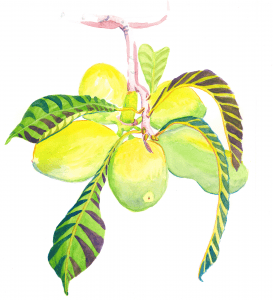Are you a fan of pawpaws? These custardy fruits can be hard to come across, so this guide provides information on how to grow your own pawpaw from seed, and how to care for grafted seedlings.
The Cornell pawpaw planting is the only commercial-scale pawpaw grove in New York, with approximately 100 trees lined up in 5 rows. This guide was written in consultation with nurseries that grow pawpaws, pawpaw growers, and agricultural researchers at Cornell University. It provides information about how to store pawpaw fruit for commercial sale, and the genetic background of pawpaw varieties grown in the Finger Lakes pawpaw orchard.
As an edible and ornamental tree, pawpaws can create a tropical feel in any landscape, with their drooping leaves that can grow up to one foot long—these turn lemon-yellow in the autumn. Pawpaw bark, seeds, and leaves contain insecticidal compounds that few bugs enjoy eating, with one notable exception: caterpillars of the zebra swallowtail butterfly are happy to munch on pawpaw foliage. Look for smooth-skinned caterpillars with a prominent hunchback. Pawpaw flowers are large, crimson-colored and pungent-smelling, attracting mayflies and other detritivores for pollination. Pawpaws need to exchange pollen to bear fruit, but each tree will make male and female flowers—so plant several trees or exchange a flowering branch with a neighbor and use a paintbrush to hand-pollinate. Pawpaws will take between 5 to 8 years to set fruit after planting. In fall, look for round buds on young twigs. These will become flowers, while slim, pointy buds will become leaves.

Culinary innovators in New York have begun selling pawpaw beer, pawpaw liqueur, and a host of seasonal fresh-fruit offerings. We are excited to see this rising interest in pawpaws and hope this guide will encourage more thinking about this hardy fruit.
You can read the “Pawpaws in New York” guide at this link.

